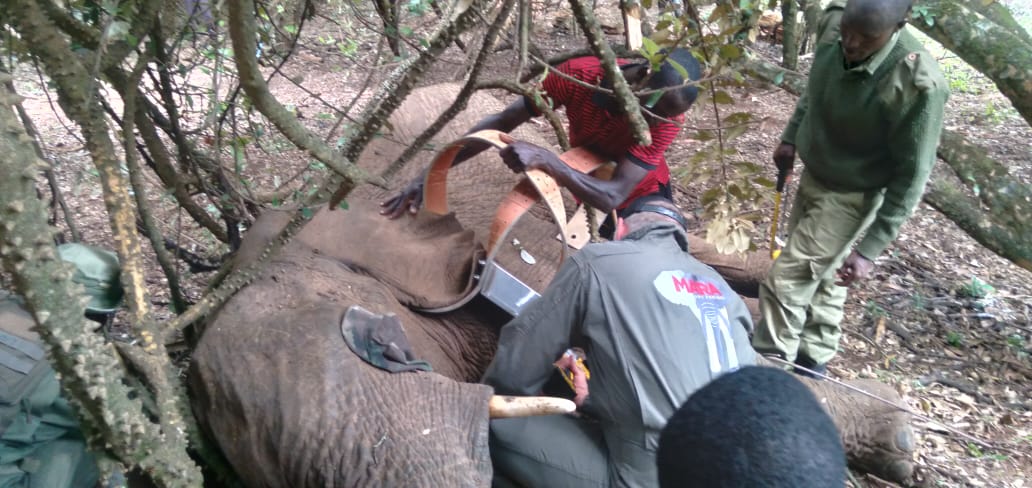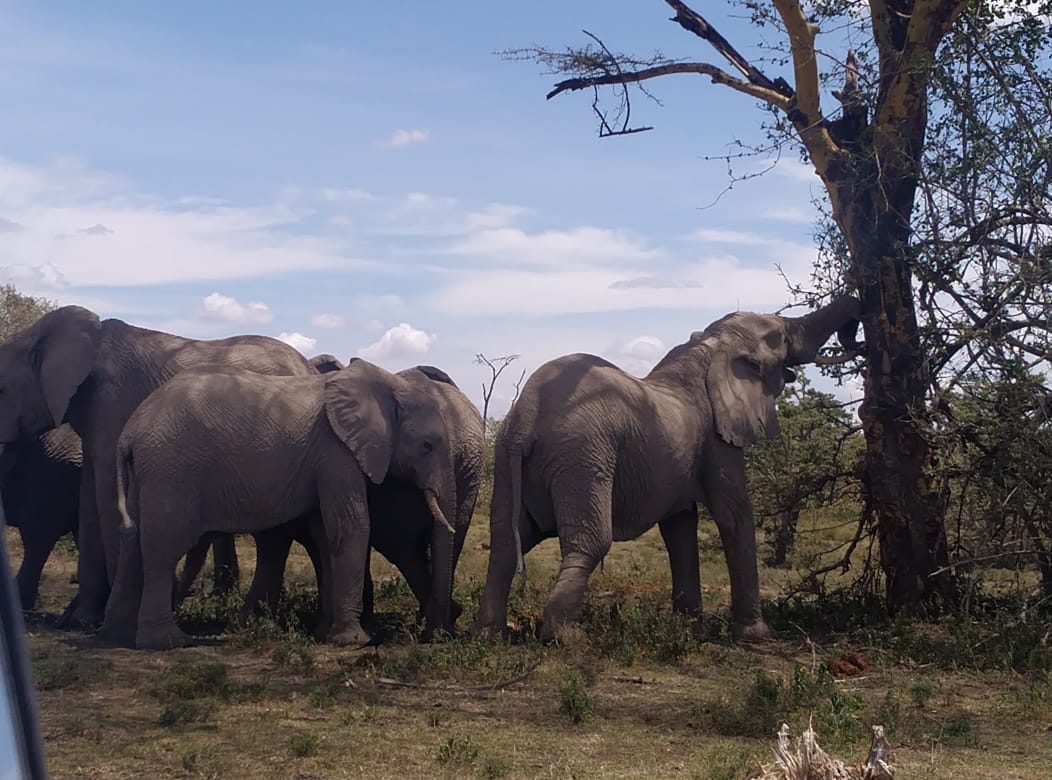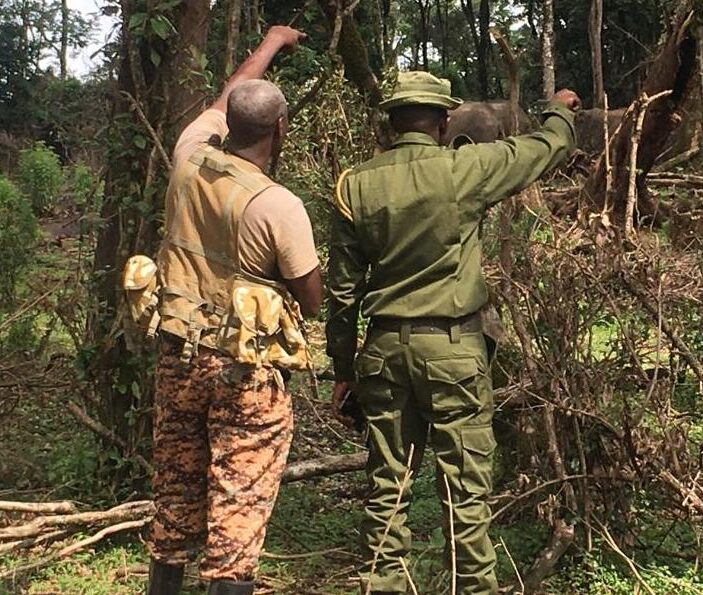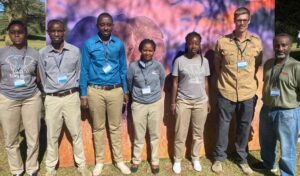 The Mara Elephant Project Research Department had the opportunity to spend quality time with a close partner EarthRanger in the fourth quarter. In November, most of the members of our team joined EarthRanger at a user conference in Kenya. The conference was attended by over 300 people from organizations around the globe. MEP was proud to be an early adopter of this revolutionary technology as Director of Research and Conservation Dr. Jake Wall is a co-founder alongside Ted Schmitt and Paul Allen. Jake gave a presentation on MEP’s latest bespoke technology Ecoscope and it was standing room only, and Conservation Officer Wilson Sairowua participated in the Communities in Conservation discussion. We were extremely proud to join our partners from near and far at the conference to learn more about the amazing work undertaken in conservation.
The Mara Elephant Project Research Department had the opportunity to spend quality time with a close partner EarthRanger in the fourth quarter. In November, most of the members of our team joined EarthRanger at a user conference in Kenya. The conference was attended by over 300 people from organizations around the globe. MEP was proud to be an early adopter of this revolutionary technology as Director of Research and Conservation Dr. Jake Wall is a co-founder alongside Ted Schmitt and Paul Allen. Jake gave a presentation on MEP’s latest bespoke technology Ecoscope and it was standing room only, and Conservation Officer Wilson Sairowua participated in the Communities in Conservation discussion. We were extremely proud to join our partners from near and far at the conference to learn more about the amazing work undertaken in conservation.
I’ve been to every one (but one) since the conference started in 2015. Having developed the initial version of EarthRanger, it was very nice to see how far the software has come and been adopted globally. The Vulcan/AI2 team have done an amazing job and we’re honored to continue a close collaboration.
Dr. Jake Wall
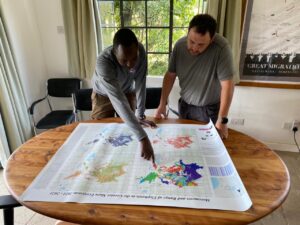 We also hosted EarthRanger CEO Jes Lefcourt and the mobile development team at MEP’s headquarters in the Mara. It was very beneficial to have face time with a close partner. Jake had the pleasure of participating on the selection committee for the 2022 Conservation Tech Awards granted by EarthRanger. Congratulations to Club Arribada and MoveApps for being the winners of the $15,000 grants to help accelerate innovative and impactful work in wildlife and ecological conservation.
We also hosted EarthRanger CEO Jes Lefcourt and the mobile development team at MEP’s headquarters in the Mara. It was very beneficial to have face time with a close partner. Jake had the pleasure of participating on the selection committee for the 2022 Conservation Tech Awards granted by EarthRanger. Congratulations to Club Arribada and MoveApps for being the winners of the $15,000 grants to help accelerate innovative and impactful work in wildlife and ecological conservation.
In the fourth quarter, we also hosted George Wittemyer and Nathan Hahn from Colorado State University. They worked with Jake on Ecoscope, our long-term monitoring program and had a chance to get into the field, which included joining the re-collaring operation for Kiambi. We also welcomed the Giraffe Conservation Foundation to MEP’s research camp and Jared Stabach, a research ecologist at the Smithsonian Conservation Biology Institute’s Conservation Ecology Center and frequent collaborator.
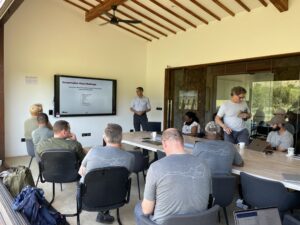 Jake had the opportunity to visit the Grumeti Fund in Tanzania in October to join others for a conservation technology workshop focusing on conflict, camera traps, wildlife tracking and protected area management. He visited the new RISE Facility, a collaboration between the Grumeti Fund and MASS that is an extremely impressive research facility in the Western Serengeti Corridor.
Jake had the opportunity to visit the Grumeti Fund in Tanzania in October to join others for a conservation technology workshop focusing on conflict, camera traps, wildlife tracking and protected area management. He visited the new RISE Facility, a collaboration between the Grumeti Fund and MASS that is an extremely impressive research facility in the Western Serengeti Corridor.
We welcomed a new member to the department, Eric Gitonga. Eric started in October and is a software developer working on advancing MEP’s bespoke conservation technologies. We’ve partnered with the One Mara Research Hub to lead the development of a monitoring framework for the GME that will help to connect data and analyses being conducted by a variety of organizations to managers and policy makers, making it easier to base decisions on sound science. We had our first workshop in November with 15 people in attendance and we should finalize an initial draft soon.
The fence line mapping team continues to make progress mapping the Mara’s fences. They mapped 125 km of fences in the fourth quarter and 74 landcover ground truthing points.
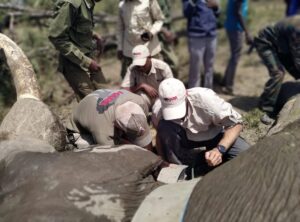 There was one new elephant collar deployed and one currently monitored elephant re-collared in the fourth quarter. Kiambi was re-collared on October 19 by Kenya Wildlife Service (KWS), the Wildlife Research and Training Institute (WRTI) and MEP. He is a large bull elephant in his late 30s who was originally collared by KWS, World Wildlife Fund and MEP in 2016 to track his movements in an area with increased infrastructure development to react to mitigate conflict and monitor his range over time. Kiambi is an interesting elephant to track because he has very distinct wet and dry season movements and spends over 30% of his time in unprotected areas. The MEP mobile team alongside CEO Marc Goss and Jake partnered with KWS Vet Dr. Michael Njoroge for the collaring operation, and while Kiambi was asleep, a couple of old wounds were re-treated by the vet. KWS, WRTI and MEP will continue to closely monitor his movements, especially in unprotected areas, to rapidly respond if conflict arises. The second elephant, a female named Bea, was collared in the Marmanet Forest.
There was one new elephant collar deployed and one currently monitored elephant re-collared in the fourth quarter. Kiambi was re-collared on October 19 by Kenya Wildlife Service (KWS), the Wildlife Research and Training Institute (WRTI) and MEP. He is a large bull elephant in his late 30s who was originally collared by KWS, World Wildlife Fund and MEP in 2016 to track his movements in an area with increased infrastructure development to react to mitigate conflict and monitor his range over time. Kiambi is an interesting elephant to track because he has very distinct wet and dry season movements and spends over 30% of his time in unprotected areas. The MEP mobile team alongside CEO Marc Goss and Jake partnered with KWS Vet Dr. Michael Njoroge for the collaring operation, and while Kiambi was asleep, a couple of old wounds were re-treated by the vet. KWS, WRTI and MEP will continue to closely monitor his movements, especially in unprotected areas, to rapidly respond if conflict arises. The second elephant, a female named Bea, was collared in the Marmanet Forest.
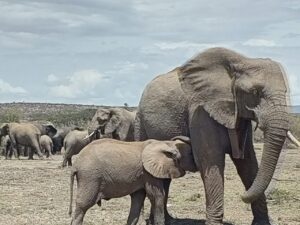 There were several collared elephants monitored or involved in conflict incidents in the fourth quarter. Collared elephants Chelsea and Natasha were monitored by the MEP mobile ranger team in a herd of almost 100 elephants. Chelsea was seen nursing her calf and Natasha was enjoying a black acacia.
There were several collared elephants monitored or involved in conflict incidents in the fourth quarter. Collared elephants Chelsea and Natasha were monitored by the MEP mobile ranger team in a herd of almost 100 elephants. Chelsea was seen nursing her calf and Natasha was enjoying a black acacia.
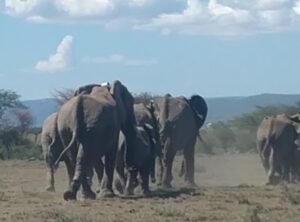 In December, MEP rangers responded to Chelsea and Kiambi, and a herd of 37, inside fences in a community area. They successfully pushed the herd out of the community’s land and into the nearby safety of a conservancy. In late December, the MEP “Kilo” team responded to collared elephants Indy and Natasha that were part of a herd nearing a settlement. They were able to push them away preventing any damage to crops, infrastructure and keeping the community safe. The “Golf” team had several sightings and responded to conflict with collared elephant Fitz and his herd of 70 elephants.
In December, MEP rangers responded to Chelsea and Kiambi, and a herd of 37, inside fences in a community area. They successfully pushed the herd out of the community’s land and into the nearby safety of a conservancy. In late December, the MEP “Kilo” team responded to collared elephants Indy and Natasha that were part of a herd nearing a settlement. They were able to push them away preventing any damage to crops, infrastructure and keeping the community safe. The “Golf” team had several sightings and responded to conflict with collared elephant Fitz and his herd of 70 elephants.
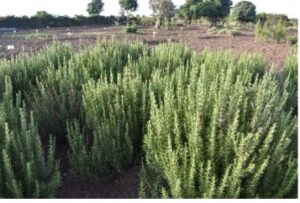 The MEP Co-Existence Farm launched an exciting new venture in the fourth quarter, a medicinal garden. The MEP Medicinal Garden will focus on growing over 30 traditional medicinal plants to test the predation levels. Medicinal plants are not only useful, but previous research has shown that they have a low predation level. The medicinal garden will also help the community to preserve the historical knowledge about medicinal plants, contribute to biodiversity and help us look into a value addition potential. We’ve already planted over 10 crops and received apothecary heirloom seeds to cultivate. More to come on this exciting new project.
The MEP Co-Existence Farm launched an exciting new venture in the fourth quarter, a medicinal garden. The MEP Medicinal Garden will focus on growing over 30 traditional medicinal plants to test the predation levels. Medicinal plants are not only useful, but previous research has shown that they have a low predation level. The medicinal garden will also help the community to preserve the historical knowledge about medicinal plants, contribute to biodiversity and help us look into a value addition potential. We’ve already planted over 10 crops and received apothecary heirloom seeds to cultivate. More to come on this exciting new project.
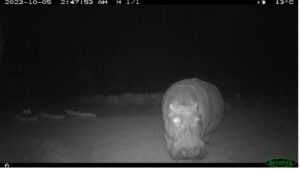 In terms of predation, October and November were fairly dry and the farm experienced a rainy December. The dry conditions meant the farm had hippos visiting regularly in search for food. They noted a big change in their eating patterns as each day they cleared five plots of each crop that they’d never predated previously. In the beginning of November, the farm had hippos selecting the palatable crops to them and elephants visited two times during the month, but zero predation was observed. The rainy December meant that the ditch deterrent deteriorated, and the elephants quickly took advantage of that to raid the maize.
In terms of predation, October and November were fairly dry and the farm experienced a rainy December. The dry conditions meant the farm had hippos visiting regularly in search for food. They noted a big change in their eating patterns as each day they cleared five plots of each crop that they’d never predated previously. In the beginning of November, the farm had hippos selecting the palatable crops to them and elephants visited two times during the month, but zero predation was observed. The rainy December meant that the ditch deterrent deteriorated, and the elephants quickly took advantage of that to raid the maize.
Another exciting development after celebrating a year of the farm in the fourth quarter is that they have had an increasing number of community members visit from near and far. It has been a great way to collaborate and share ideas, and it is becoming even more important to launch a resource center to host visitors as a central education hub for co-existence farming. Hopefully more to come on that in 2023.

